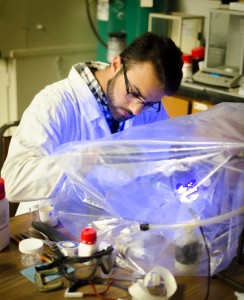Knowledge and Assessment of Hydration in Heat Acclimatized Collegiate Male Soccer Athletes
Summer 2015
Investigators: Abigail Colburn1, Robert A. Huggins1, Andrea Fortunati1, David Looney1, Chris West1, Lawrence E. Armstrong, FACSM1, and Douglas J. Casa, FACSM1
1University of Connecticut
Fluid consumption during exercise can be influenced by vessel type and hydration knowledge, however athletes often are not given a choice of vessel and furthermore they are unaware of their individual fluid needs. PURPOSE: The aim of this single-blind matched pairs laboratory study was to investigate if hydration vessel has an impact on water consumption volume and if athletes are aware of their total body fluid balance. METHODS: Nineteen Division I male soccer athletes (age, 20±1 y; height, 180±7 cm; body mass, 78.68±7.39 kg) performed a standard 60 minute sweat electrolyte test in the heat and completed a hydration knowledge and strategy questionnaire afterwards. Ten participants consumed unlimited water from 1L commercial sports drink bottles typically used in practice (BTL), while 9 participants consumed unlimited water from a commercial water bladder hidden above them in the ceiling, only with access to the straw (BLA). Testing was conducted in a controlled environmental chamber, ambient temperature was 29.68±5.08°C, relative humidity 49.32±10.65%, and WBGT 19.32±4.43°C. Primary variables of interest included actual fluid consumed, perceived fluid consumed, actual sweat rate, and perceived sweat rate. Between group differences were analyzed using paired samples t-tests (a= p<0.05). RESULTS: There were no differences between BTL and BLA for amount of actual fluid consumed (BTL, 414.44±397.18mL; BLA, 390±288.21mL; p=0.879) actual fluid lost (BTL, 1415.56±368.62; BLA, 1344±452.14mL; p=0.712), perceived fluid consumed (BTL, 833±673mL; BLA, 565±461.64; p=0.321) or perceived fluid lost (BTL, 2444±1333; BLA, 2063±1778; p=0.607). However, when groups were combined, significant differences were found between the following variables. Perceived consumption was 692±572mL and actual consumption was 401.58±334.37mL (p=0.016). Perceived sweat losses were 2244±1552mL and actual sweat losses were 1377.89±404.90mL (p=0.015). Athletes only consumed 22.5±16.9% of actual fluid losses. Actual consumed and actual sweat losses were also significantly correlated (p<0.001). CONCLUSION: Although there were no differences between the type of vessel in which fluid was administered, NCAA Division I soccer athletes significantly overestimated both the amount of fluid they consumed and actual sweat losses during 60 minutes of exercise in the heat. These findings suggest that athletes are unaware of their individualized fluid needs, which may lead to involuntary dehydration.


